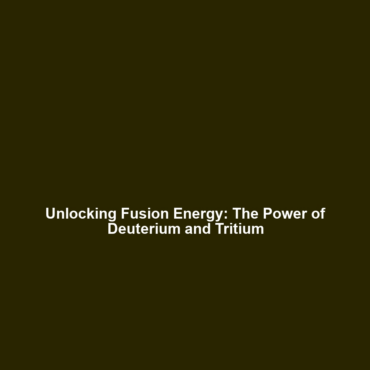Nuclear Fusion Reactions: Fusing Deuterium and Tritium for Clean Energy
Category: Fusion Energy
Introduction
Nuclear fusion reactions represent a groundbreaking method for producing immense energy through the fusion of deuterium, derived from seawater, and tritium, which can be obtained from lithium. This process generates helium and a neutron, releasing substantial energy, which positions fusion energy as a key player in the pursuit of sustainable energy solutions. As the world seeks cleaner alternatives to fossil fuels, understanding nuclear fusion is crucial for harnessing its potential to provide safe and abundant energy resources.
Key Concepts
Understanding Nuclear Fusion
Nuclear fusion occurs when two light atomic nuclei combine to form a heavier nucleus, releasing energy in the process. The primary reaction for producing energy in fusion reactors involves deuterium ({^2H}) and tritium ({^3H}). The overall reaction can be summarized as:
{^2H} + {^3H} → {^4He} + n + Energy
This fusion reaction not only produces helium but also a neutron, making it an attractive option for generating energy without the hazardous byproducts associated with nuclear fission.
Importance of Fusion Energy
Fusion energy promises to be a reliable and virtually limitless source of clean energy. As both deuterium and lithium are abundantly available, exploiting these resources can significantly reduce our dependence on nonrenewable energy sources.
Applications and Real-World Uses
How Nuclear Fusion is Used in Fusion Energy
The practical applications of nuclear fusion extend beyond theoretical models and laboratory experiments. Significant uses include:
- Electricity Generation: Fusion reactors, once fully realized, could provide vast amounts of electricity to power homes and industries with minimal environmental impact.
- Space Exploration: Fusion propulsion systems offer the potential for faster and more efficient space travel, reducing the time taken to reach distant celestial bodies.
- Medical Applications: Neutrons produced during fusion reactions are useful in neutron therapy for cancer treatment.
Current Challenges
Challenges of Nuclear Fusion
Despite its benefits, several challenges impede the development and application of nuclear fusion:
- Technological Hurdles: Developing materials that can withstand the extreme conditions inside a fusion reactor remains a significant challenge.
- Cost: The investment required for research and development in fusion technology is substantial, limiting the pace of progress.
- Public Perception: Concerns about safety and environmental impact can hinder public and governmental support for fusion energy initiatives.
Future Research and Innovations
Innovations in Nuclear Fusion Research
The future of nuclear fusion research looks promising, with numerous innovative projects underway:
- ITER Project: The International Thermonuclear Experimental Reactor (ITER) in France is a major collaborative effort to demonstrate the feasibility of fusion energy on a large scale.
- SPARC Initiative: This project aims to develop a compact fusion pilot plant, leveraging advanced superconducting magnet technology.
- Private Sector Investments: Increasing investments from private companies like Helion and TAE Technologies are accelerating the pace of innovation in fusion energy.
Conclusion
Nuclear fusion reactions, particularly the fusion of deuterium and tritium, represent a transformative opportunity in the field of fusion energy. By addressing current challenges and continuing to innovate, the quest for sustainable and clean energy can become a reality. To learn more about the advancements in fusion energy and its impact on our future, explore our related articles on renewable energy technologies and breakthroughs in nuclear physics.


